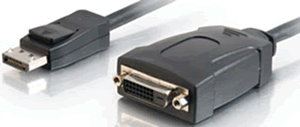DisplayPort in A/V Applications in the Next Five Years
January 2014
By Joseph D. Cornwall, CTS-D, Lastar Inc.
 This article is excerpted from a white paper entitled, “5 A/V Technologies That Will Define the Next 5 Years.” To read the white paper in its entirety, please visit C2G online.
This article is excerpted from a white paper entitled, “5 A/V Technologies That Will Define the Next 5 Years.” To read the white paper in its entirety, please visit C2G online.
Lastar’s Joseph Cornwall explains why DisplayPort interfaces will be one of the five technologies to change A/V applications in the next five years.
In 2006, the Video Electronics Standards Association (VESA) approved a new technology for transporting audio/video (A/V) data streams and a bi-directional auxiliary channel between a computer and a monitor, or between a computer and a home theater system. It made its debut as a license-free, royalty-free alternative to the rapidly growing HDMI connection, and as a replacement for the aging Low Voltage Differential Signaling (LVDS) technology that had been the computer world’s interface of choice since its introduction in 1994. VESA envisioned DisplayPort becoming a replacement for VGA, DVI, and FPD-Link, with backward compatibility to VGA and DVI by using active adapter dongles. In its original incarnation, DisplayPort was essentially incompatible with HDMI and other TMDS and HDCP-encrypted content.
DisplayPort is the first A/V interface to rely on packetized data transmission, a form of digital communication also found in PCIe, Ethernet, and USB. Unlike earlier A/V systems, where the signal channels relied on a separate clock signal to coordinate the image, the DisplayPort protocol is based on small data packets known as micro packets, which can embed the clock signal within the data stream. This gives DisplayPort the ability to deliver very high resolutions, or even transport multiple images, over the various twisted pairs inside a single interconnect assembly. In a world where extended desktops and multiple monitor installations are quickly becoming the norm, this is an enviable performance advantage.
DisplayPort 1.2 is capable of emitting HDMI or DVI-D TMDS signals through the use of a simple passive converter. DisplayPort has been HDCP-compliant since the DP1.1 standard. The DisplayPort 1.2a standard was released in January of 2013 and includes support for Multi-Stream Transport (MST), Ultra HD resolutions, and many more performance enhancements.
DisplayPort is replacing VGA connectivity on most computers because of its rich feature set, its compatibility with CMOS fabrication techniques and its compatibility with HDMI and HDCP technologies. DisplayPort was included in about one in 20 desktops and one in 50 laptops as of 2009. DisplayPort use is expected to be included in 19 out of 20, or 95%, of all computers by 2014 as the industry continues to phase out LVDS. Much of this exponential growth in DisplayPort++ deployment is expected to occur in 2014 and 2015.
While the three major vendors of central and graphics processing units — Intel, AMD, and nVidia — have moved to integrate DisplayPort into their current products, this doesn’t signal a competition between DisplayPort and HDMI as A/V connectivity standards. Both interfaces will serve distinct markets.The DisplayPort standard defines an HDMI “compatibility mode,” identified by the DP++ logo that allows devices so equipped to seamlessly switch to an HDMI output format when a passive adapter is connected. This ensures that computers and devices leveraging a DisplayPort connection remain compatible with the very large installed base of HDMI-enabled devices.
According to International Data Corporation (IDC) analysis, DisplayPort market penetration will experience a compounded annual growth rate of 106% between 2009 and 2014. The firm Research and Markets stated in its “Global HDMI and DisplayPort-enabled Equipment Market 2012-2016” report that DisplayPort Multi-Mode market penetration would grow at a combined annualized growth rate (CAGR) of 31.6% over the four-year period covered by the report. DisplayPort is quickly becoming a key technology of the A/V market, with no end to its growth in sight.
Joseph D. Cornwall is a technology evangelist at Lastar Inc. Visit Lastar online.

